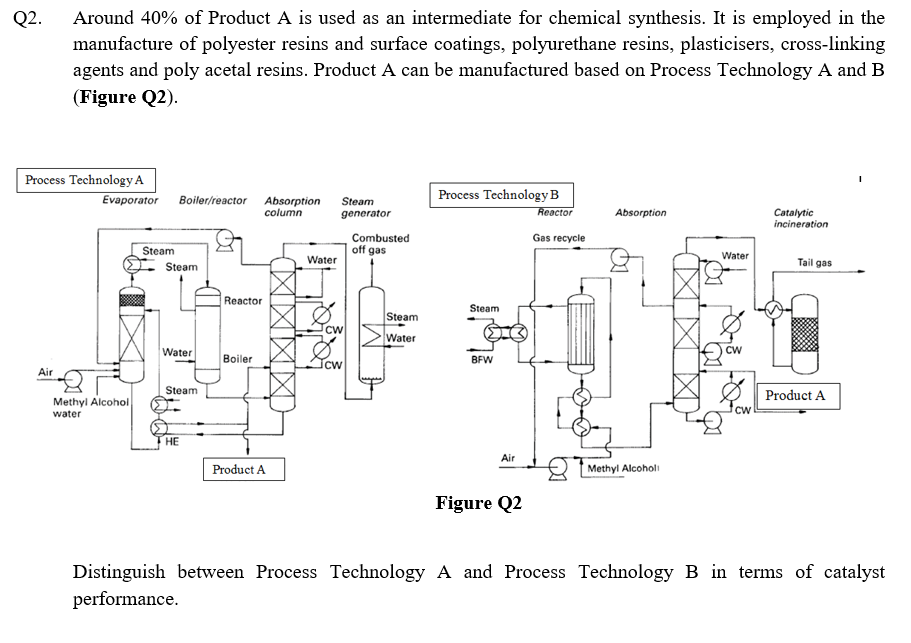Q2. Around 40% of Product A is used as an intermediate for chemical synthesis. It is employed in the manufacture of polyester resins and surface coatings, polyurethane resins, plasticisers, cross-linking agents and poly acetal resins. Product A can be manufactured based on Process Technology A and B (Figure Q2). Reactor Absorption Gas recycle Process Technology A Evaporator Boiler/reactor Absorption Steam column Process Technology B Steam generator Combusted off gas Water Steam Reactor Steam Steam CW Water Water Boiler BFW CW Air Steam Methyl Alcohol water HE Product A Air Methyl Alcoholi Figure Q2 Catalytic incineration Water Tail gas CW Product A cw Distinguish between Process Technology A and Process Technology B in terms of catalyst performance.
Q2. Around 40% of Product A is used as an intermediate for chemical synthesis. It is employed in the manufacture of polyester resins and surface coatings, polyurethane resins, plasticisers, cross-linking agents and poly acetal resins. Product A can be manufactured based on Process Technology A and B (Figure Q2). Reactor Absorption Gas recycle Process Technology A Evaporator Boiler/reactor Absorption Steam column Process Technology B Steam generator Combusted off gas Water Steam Reactor Steam Steam CW Water Water Boiler BFW CW Air Steam Methyl Alcohol water HE Product A Air Methyl Alcoholi Figure Q2 Catalytic incineration Water Tail gas CW Product A cw Distinguish between Process Technology A and Process Technology B in terms of catalyst performance.
Introduction to Chemical Engineering Thermodynamics
8th Edition
ISBN:9781259696527
Author:J.M. Smith Termodinamica en ingenieria quimica, Hendrick C Van Ness, Michael Abbott, Mark Swihart
Publisher:J.M. Smith Termodinamica en ingenieria quimica, Hendrick C Van Ness, Michael Abbott, Mark Swihart
Chapter1: Introduction
Section: Chapter Questions
Problem 1.1P
Related questions
Question

Transcribed Image Text:Q2.
Around 40% of Product A is used as an intermediate for chemical synthesis. It is employed in the
manufacture of polyester resins and surface coatings, polyurethane resins, plasticisers, cross-linking
agents and poly acetal resins. Product A can be manufactured based on Process Technology A and B
(Figure Q2).
Process Technology A
Evaporator
Process TechnologyB
Boiler/reactor
Absorption
column
Steam
Reactor
Catalytic
incineration
generator
Absorption
Combusted
Gas recycle
Steam
off gas
Water
Water
Tail gas
Steam
Reactor
Steam
Steam
Cw
Water
Water
CW
Boiler
BFW
Icw
Air
Steam
Product A
Methyl Alcohol
water
НЕ
Air
Product A
Methyl Alcoho
Figure Q2
Distinguish between Process Technology A and Process Technology B in terms of catalyst
performance.
Expert Solution
This question has been solved!
Explore an expertly crafted, step-by-step solution for a thorough understanding of key concepts.
Step by step
Solved in 3 steps with 7 images

Recommended textbooks for you

Introduction to Chemical Engineering Thermodynami…
Chemical Engineering
ISBN:
9781259696527
Author:
J.M. Smith Termodinamica en ingenieria quimica, Hendrick C Van Ness, Michael Abbott, Mark Swihart
Publisher:
McGraw-Hill Education

Elementary Principles of Chemical Processes, Bind…
Chemical Engineering
ISBN:
9781118431221
Author:
Richard M. Felder, Ronald W. Rousseau, Lisa G. Bullard
Publisher:
WILEY

Elements of Chemical Reaction Engineering (5th Ed…
Chemical Engineering
ISBN:
9780133887518
Author:
H. Scott Fogler
Publisher:
Prentice Hall

Introduction to Chemical Engineering Thermodynami…
Chemical Engineering
ISBN:
9781259696527
Author:
J.M. Smith Termodinamica en ingenieria quimica, Hendrick C Van Ness, Michael Abbott, Mark Swihart
Publisher:
McGraw-Hill Education

Elementary Principles of Chemical Processes, Bind…
Chemical Engineering
ISBN:
9781118431221
Author:
Richard M. Felder, Ronald W. Rousseau, Lisa G. Bullard
Publisher:
WILEY

Elements of Chemical Reaction Engineering (5th Ed…
Chemical Engineering
ISBN:
9780133887518
Author:
H. Scott Fogler
Publisher:
Prentice Hall


Industrial Plastics: Theory and Applications
Chemical Engineering
ISBN:
9781285061238
Author:
Lokensgard, Erik
Publisher:
Delmar Cengage Learning

Unit Operations of Chemical Engineering
Chemical Engineering
ISBN:
9780072848236
Author:
Warren McCabe, Julian C. Smith, Peter Harriott
Publisher:
McGraw-Hill Companies, The